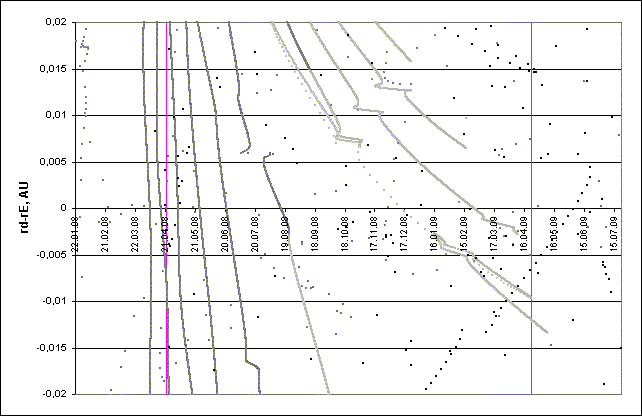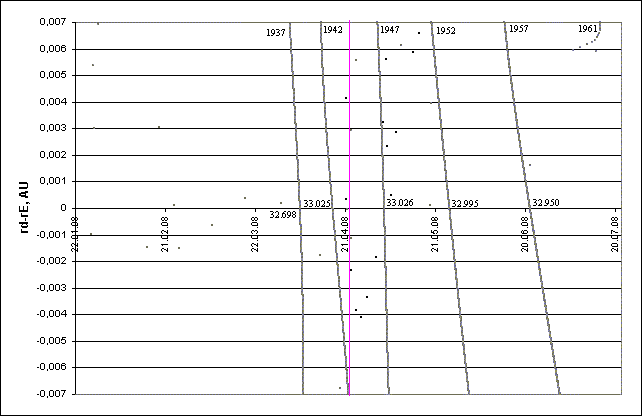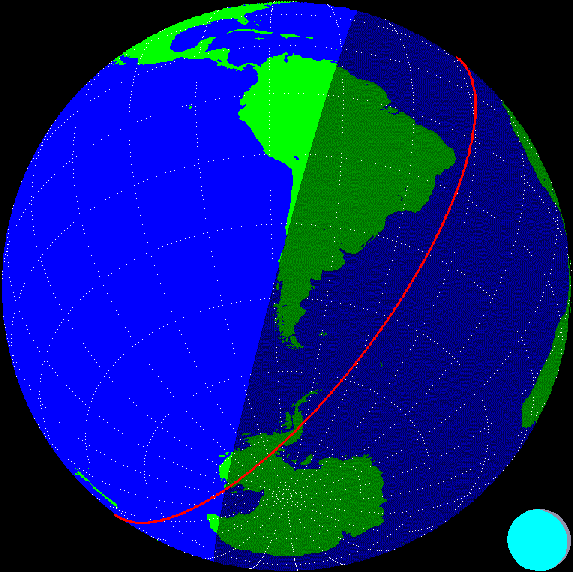pi-Puppids 2007: prediction of activity
to the list of predictions
Introduction
Computation characteristics
We'd like to introduce the results of the pi-Puppids meteor stream simulation aimed to the prediction of shower activity in 2008. The simulation was made for the trails of latest 52 revolutions, i.e, from the 1739 trail. The Author used the program by S. Shanov and S. Dubrovsky "Comet's Dust 2.0" to calculate orbital elements of ejected meteor particles. To estimate expected ZHRs for different encounters the model by E. Lyytinen and T. van Flandern given in their paper [2] was used with some Author's alterations made in order to adopt the model for ejection velocity (Vej) instead of da0 (difference in a-semimajor axis) and to convert the model from the Leonid stream (for which it was originally created) to the pi-Puppids. The computation considered only gravitational forces, however, the results are on the whole in good accordance with these of other researchers. The following parts of trails were computed: the first 15 rev. trails for ejection velocities [-50;100] m/s, 16-30 rev. trails - [-30;50] m/s, older than 30 rev. trails - [-20;30].
Results
The Fig. 1 below shows the distribution of 26P dust trails in the vicinity of the Earth's orbit within the period of 21.01.2008 - 22.07.2009. The vertical axis shows the minimal distance between trails particles and the Earth's orbit. So far, the Fig. 1 displays the moments of passage of minimal distances to the Earth's orbit for various trails and particles and these distances themselves.
Computation characteristics
We'd like to introduce the results of the pi-Puppids meteor stream simulation aimed to the prediction of shower activity in 2008. The simulation was made for the trails of latest 52 revolutions, i.e, from the 1739 trail. The Author used the program by S. Shanov and S. Dubrovsky "Comet's Dust 2.0" to calculate orbital elements of ejected meteor particles. To estimate expected ZHRs for different encounters the model by E. Lyytinen and T. van Flandern given in their paper [2] was used with some Author's alterations made in order to adopt the model for ejection velocity (Vej) instead of da0 (difference in a-semimajor axis) and to convert the model from the Leonid stream (for which it was originally created) to the pi-Puppids. The computation considered only gravitational forces, however, the results are on the whole in good accordance with these of other researchers. The following parts of trails were computed: the first 15 rev. trails for ejection velocities [-50;100] m/s, 16-30 rev. trails - [-30;50] m/s, older than 30 rev. trails - [-20;30].
Results
The Fig. 1 below shows the distribution of 26P dust trails in the vicinity of the Earth's orbit within the period of 21.01.2008 - 22.07.2009. The vertical axis shows the minimal distance between trails particles and the Earth's orbit. So far, the Fig. 1 displays the moments of passage of minimal distances to the Earth's orbit for various trails and particles and these distances themselves.

Fig. 1. Space-temporal projection of pi-Puppid trails parts onto their minimal distance passages (correspondence between colours of the particles and their ejection velocities can be seen here).
So far, in 2008 the Earth's orbit is crossed by several vertical trails. These are young trails, keeping a good regular structure. The period around maximum time of the shower in 2008 is given on the Fig. 2 in more detailed scale. It shows the distribution of 26P dust trails in the vicinity of the Earth's orbit within the period of 21.01.2008 - 22.07.2008.

Fig. 1. Space-temporal projection of pi-Puppid trails parts onto their minimal distance passages (correspondence between colours of the particles and their ejection velocities can be seen here).
On the Fig.2 for regular trails the years of their ejection are given, and the point of each trail intersection with the Earth's orbit is marked with corrisponding solar longutude value. We can see, that three trails are most close the the time of the shower maximum, which is marked with red line on the Fig 2. These are 1937, 1942 and 1947 trails, intersecting the Earth's orbit on 5 April, 16 April and 4 May, respectively. We should undeline, that in the first approximation this result confirms very well that of J. Vaubaillon, who pointed to the encounter with 1937, 1942 and 1947 trails for pi-Puppids 2008. He estimated, that these trails should give activity of 10, 4 and 10 meteors on ZHR scale, respectively, and their maximum times lay within interval of 22:50-23:20 UT on 22 April (maybe only for radioobservers) [3].
Below in the table 1 the characteristics of those three vertival trails in the points of their intersetions with the Earth's orbit:
where trail - year of trail ejection; rD-rE_e - effective distance between the Earth's and trail particles orbits; Vej - velocity of particles ejection on the given trail part (positive values means the particles were ejected against the comet movement, negavive - particles were ejected along the comet movement); fM(fMD) - the characteristic of longitudinal density of the trail, it is derived from the time interval between passages of minimal distance to the Earth's orbit by particles with different ejection velocities; SL - solar longitude corresponding to the maximum; MT - assumed time of maximum.
As shown in the table, the intersection of 1942 trail is the closest to the time of the shower maximum. However this trail is much less dense than two other trails (it's reflected in parameter fM(fMD) value). The effective distance of the densest trails is 2 times higher, and 1937 trails is even more far. Also, ejection velocities for all 3 trails are near 30 m/s, it means that the Earth will encounter mostly small particles. It suggest activity mostly for radioobservers (this suggestion is also goes along with Vaubaillon results).
Computed expected ZHR for 1937, 1942 and 1947 trails are 0, 2 and 2, respectively. Considering that computed maximum times for 1942 and 1947 trail are practically coinsiding, around 22:10-22:15 UT on 22 April we could expect e weak pi-Puppid activity with ZHR of 5-10 meteors with low average brightness and likely more strong action for radioobservers. Theoretical radiants are: 1942 trail: RA=113.0°, Dec=-42.6°, 1942 trail: RA=112.9°, Dec=-42.7° [4]. So far, intensity expectations are also close to those of Vaubaillon prediction. The single significant difference is in expected times of maximum, it accounts for about 1 hour.
Below in the table 1 the characteristics of those three vertival trails in the points of their intersetions with the Earth's orbit:
| encounters with vertical trails | |||||
| trail | rD-rE | Vej | fM(fMD) | SL | MT |
| - | AU | m/s | - | ° | UT |
| 1937 | 0.00216 | 36.03 | 12.510 | 32.698 | 22.04.2008 14:10 |
| 1942 | 0.00079 | 28.30 | 2.589 | 33.025 | 22.04.2008 22:12 |
| 1937 | -0.00144 | 31.02 | 30.224 | 33.026 | 22.04.2008 22:13 |
As shown in the table, the intersection of 1942 trail is the closest to the time of the shower maximum. However this trail is much less dense than two other trails (it's reflected in parameter fM(fMD) value). The effective distance of the densest trails is 2 times higher, and 1937 trails is even more far. Also, ejection velocities for all 3 trails are near 30 m/s, it means that the Earth will encounter mostly small particles. It suggest activity mostly for radioobservers (this suggestion is also goes along with Vaubaillon results).
Computed expected ZHR for 1937, 1942 and 1947 trails are 0, 2 and 2, respectively. Considering that computed maximum times for 1942 and 1947 trail are practically coinsiding, around 22:10-22:15 UT on 22 April we could expect e weak pi-Puppid activity with ZHR of 5-10 meteors with low average brightness and likely more strong action for radioobservers. Theoretical radiants are: 1942 trail: RA=113.0°, Dec=-42.6°, 1942 trail: RA=112.9°, Dec=-42.7° [4]. So far, intensity expectations are also close to those of Vaubaillon prediction. The single significant difference is in expected times of maximum, it accounts for about 1 hour.

Fig. 3. The Earth as seen from coming pi-Puppid meteors (Radiant: RA=113°, Dec=-43°) during the maximum from 1942 and 1947 trails at 22:12 UT on 22 April. Red line shows the border of hemisphere where the Moon is above horizon (it is shown with in the corner of the Fig. 3 according to its phase).
The Fig. 4 shows the map with regions where this peak will be visible if occurs at given time. So far the best place for visual observations will be mostly the territory of Brasilia (eastern part of South America). Also the radiant will be quite high above the most part of Antarcica. Radioobservations are also possible in the whole South and Central Americas. The Moon, despite its proximity to the full phase, won't create any problems for observers in Brasilia, but it will shine brightly over Antarctica.
A short look for 2009
As shown on the Fig. 1, in 2009 there is no significant trails close to the shower maximum. The channel of trails, which is expected to give acivity in 2008, will already pass in 2009. So far we do not expect pi-Puppid activity in 2009.
Conclusions
In 2008 we expect that pi-Puppids will give a small enhancement due to partiles from 1942 and 1947 trails. It should occur around 22:12 UT on 22 April. Expected intensity is 5-10 meteors on ZHR scale with low average meteor brightness and perhaps stronger action for radioobservers. The Moon won't create any problems for observations in Brasilia, but its almost full phase will be visible in Antarctica.
We should note the these results, obtained with the use of "vertical trails" approach are in good accordance with the earlier prediction made by J. Vaubaillon, whose result is confirmed so far. Notable difference (about an hour) are only for maximum time whereas the rest parameters (encountered trails, intensity, meteor brightness) are very close. Vaubaillon use the different method in his computations, so the reliability of the prediction with close results, obtained from different methods, should be considered quite high.
In 2009 we do not expect pi-Puppid activity.
Ссылки
1. "Comet's dust 2.0" program by S. Shanov and S. Dubrovsky. [Used for orbital computations.]
2. Lyytinen E, van Flandern T. "Predicting the strength of Leonid outbursts", 2000, Icarus, P. 158-160.
3. IMO Meteor Shower Calendar 2008, http://www.imo.net/calendar/2008.
4. MetRad, software for computing radiant coordinates.
A short look for 2009
As shown on the Fig. 1, in 2009 there is no significant trails close to the shower maximum. The channel of trails, which is expected to give acivity in 2008, will already pass in 2009. So far we do not expect pi-Puppid activity in 2009.
Conclusions
In 2008 we expect that pi-Puppids will give a small enhancement due to partiles from 1942 and 1947 trails. It should occur around 22:12 UT on 22 April. Expected intensity is 5-10 meteors on ZHR scale with low average meteor brightness and perhaps stronger action for radioobservers. The Moon won't create any problems for observations in Brasilia, but its almost full phase will be visible in Antarctica.
We should note the these results, obtained with the use of "vertical trails" approach are in good accordance with the earlier prediction made by J. Vaubaillon, whose result is confirmed so far. Notable difference (about an hour) are only for maximum time whereas the rest parameters (encountered trails, intensity, meteor brightness) are very close. Vaubaillon use the different method in his computations, so the reliability of the prediction with close results, obtained from different methods, should be considered quite high.
In 2009 we do not expect pi-Puppid activity.
Ссылки
1. "Comet's dust 2.0" program by S. Shanov and S. Dubrovsky. [Used for orbital computations.]
2. Lyytinen E, van Flandern T. "Predicting the strength of Leonid outbursts", 2000, Icarus, P. 158-160.
3. IMO Meteor Shower Calendar 2008, http://www.imo.net/calendar/2008.
4. MetRad, software for computing radiant coordinates.